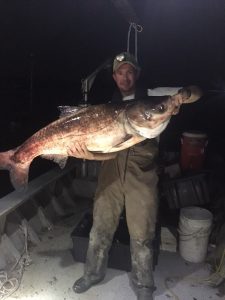 Commercial anglers netted nearly 42 tons of invasive Asian carp from Kentucky and Barkley lakes during the inaugural Carp Madness tournament in 2013.
Commercial anglers netted nearly 42 tons of invasive Asian carp from Kentucky and Barkley lakes during the inaugural Carp Madness tournament in 2013.
Carp Madness returns to the lakes in June with a new twist: it’s a tournament for bow anglers. The top prize is $10,000 for the team on the winning boat in each division, with total prizes of $23,000.
The Kentucky Department of Fish and Wildlife Resources and the Tennessee Wildlife Resources Agency are partnering with the Kentucky Fish and Wildlife Foundation, Kentucky State Parks and the Bowfishing Association of America for Carp Madness 2. The tournament is set for the night of June 23-24.
The tournament is another way to remove carp from the lake while building awareness of the invasive fish.
“We anticipate that Carp Madness 2 will remove more than 100,000 pounds of Asian carp in a single night of bowfishing,” said Ron Brooks, fisheries division director for Kentucky Fish and Wildlife. “Proceeds beyond the cost of the tournament payouts and prizes will go to the Kentucky Fish and Wildlife Foundation, which works with our department on fish and wildlife habitat, the Salato Wildlife Education Center and sponsoring the department’s summer conservation camps for kids.”
The Bowfishing Association of America is sanctioning the event.
The entry fee is $150 per boat. Contestants can pay an extra $25 for entry into the big fish contest. Teams may consist of 2-4 anglers, but no passengers.
The top three weights harvested per boat from each division (lake or river) will win prize money. First place pays $10,000 per boat, followed by $1,000 for second and $500 for third. The big fish payout will be combined for both divisions and depend on the number of entries.
Contestants who weigh in Asian carp will receive a commemorative “Carp Madness 2” T-shirt. Contestants weighing in at least 250 pounds of fish will receive raffle tickets for chances at donated prizes. The Kentucky Fish and Wildlife Foundation is providing support for raffles, t-shirts and donations to the tournament. The foundation will also sell “Carp-Madness 2” T-shirts to support Asian carp removal efforts.
The tournament begins at 7 p.m. (Central time) June 23 and continues until 7 a.m. the following morning. Launch is set for the Kentucky Dam Marina Boat Ramp, located at the Kentucky Dam Village State Resort Park near Gilbertsville, Ky. Bowfishing anglers may harvest any of the Asian carp, including the silver, bighead, grass and black carp.
Pre-registration opens today on the Bowfishing Association of America website: baastore.bigcartel.com. Participants may also register at the event (cash only).
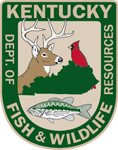 The Kentucky Department of Fish and Wildlife Resources has opened more land for public use.
The Kentucky Department of Fish and Wildlife Resources has opened more land for public use.
Old Trace Creek Wildlife Management Area (WMA) is a 323-acre property near the community of Emerson in Lewis County. Hunting on the WMA is allowed under statewide regulations.
The property was purchased with Kentucky Wetland and Stream Mitigation “Fee In-Lieu of” (FILO) Program funding for stream restoration. The FILO program is required by the U.S. Army Corps of Engineers to permanently protect stream restoration project sites through the acquisition of properties like the Old Trace Creek area. No general fund tax dollars or department license dollars were used.
“With the stream restoration project almost complete, the area is being opened for the public to enjoy,” said Mike Hardin, assistant Fisheries Division director with Kentucky Fish and Wildlife. “Not only is this project improving stream habitat, hunters and outdoors enthusiasts are being provided with a new place to enjoy.”
Old Trace Creek WMA is about 95 percent forested with the remaining open land primarily being creek drainages where stream restoration efforts are nearly complete. Visitors will encounter moderate to steep terrain with forested ridges and benches.
“There is abundant opportunity for game species as most of this track is made up of upland oak forest,” said Nathan Gregory, coordinator of Kentucky Fish and Wildlife’s Northeast Wildlife Region. “Turkey, squirrel and deer are going to be the big three. There’s the possibility of some rabbit and grouse, as well.”
To access Old Trace Creek WMA, take Exit 156 off Interstate 64, turn left on KY 59 and travel about six miles to Old Trace Creek Road/Old Trace Hill Road. Turn left and travel approximately one mile. The property is mostly on the right, with one small tract on the left that offers access to the creek. The property features three small parking areas off Old Trace Creek Road.
The property is free for the public to access. Hunters must have the proper license and permits. These are available online at fw.ky.gov, or at numerous vendors where sporting goods are sold.
Kentucky’s spring turkey season opens April 14 and continues through May 6. Kentucky’s spring squirrel season opens May 15 and continues through June 15.
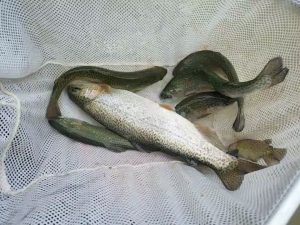
Photo: Kentucky Department Fish and Wildlife
The fisheries division of the Kentucky Department of Fish and Wildlife Resources recently added some bigger rainbow trout to its usual stockings at streams in three popular tourism destinations.
Areas receiving the upsized fish include the Middle Fork of Red River near Natural Bridge State Resort Park, East Fork of Indian Creek in the Red River Gorge National Geological Area and in Rock Creek in the Daniel Boone National Forest in McCreary County.
“We are trying to stock an average of 12-inch trout instead of the usual average of 9-inch trout,” said Tom Timmerman, Northeastern Fisheries District biologist for Kentucky Fish and Wildlife. “When we stock 12-inch average trout, some of them are larger.”
Crews stocked the Middle Fork of Red River and East Fork of Indian Creek April 4 and Rock Creek April 5. They placed 650 rainbow trout in the Middle Fork of the Red River and 850 trout in the East Fork of Indian Creek, with 100 of those fish in each stream of a larger size. Rock Creek received 2,075 trout with 275 of those fish of a larger size.
The increased size of the stocked trout is part of an effort to lure more anglers to these streams. “We want to make these destination streams and give someone incentive to come to Kentucky and trout fish the Red River Gorge area or Rock Creek,” said Justin Heflin, assistant fisheries biologist for the Northeastern Fisheries District. “If you are coming from a good ways, you want to catch a good fish.”
The stockings of larger trout will continue in October on these streams. “When we stock larger fish, it does slightly reduce the total number of trout stocked, but should not impact fishing success,” said Ron Brooks, director of Fisheries for Kentucky Fish and Wildlife. “We are limited on the number of big trout available and are concentrating on these three streams with these stockings.”
Anglers may keep up to eight rainbow trout a day from these waters from now until Sept. 30. There is no size limit for rainbow trout in these waters. Anglers keeping their catch must have the appropriate fishing license and trout permit. Trout permits are $10 and may be purchased wherever fishing licenses are sold, or bought online at fw.ky.gov.
These waters fall under special catch and release regulations for trout from Oct. 1 through March 31. During this fall/winter season, all trout caught must be released immediately.
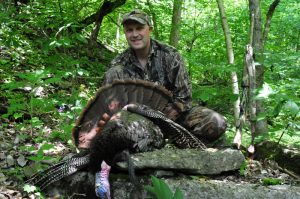
Photo: Kentucky Department Fish and Wildlife
Wildlife biologists conducting a new study want to examine at least 30 turkeys taken in Livingston and Crittenden counties during this weekend’s opener of the spring turkey season.
Zak Danks, turkey biologist for the Kentucky Department of Fish and Wildlife Resources, said concerns voiced by local hunters spurred the research.
“Folks in this area are saying they haven’t been seeing as many turkeys as in the past, and I can attest to that,” he said. “The recent downward trend in spring harvest in these two counties is puzzling, considering that in most counties, harvest – our best measure of overall abundance – has been stable or increasing.”
Biologists want to examine hunter-killed turkeys to check the body condition and look for parasites. Researchers also want to obtain samples of each animal’s blood, organs and other tissues to test for disease or other issues.
Participating turkey hunters can keep the meat, beard, spurs and tail fan. Kentucky Fish and Wildlife staff will breast out birds and answer questions from hunters.
Hunters willing to participate in the survey should take their turkeys to the inspection area at Tambco gas station, 354 West Main Street, in Salem, Ky. Kentucky Fish and Wildlife will staff the area from 8 a.m. to 6 p.m. (Central time) April 14-15.
Participating hunters must still check their birds either through the TELECHECK phone system (1-800-CHK-GAME), or online at fw.ky.gov.
“Right now, we have no evidence to suggest a disease issue or any specific threat,” said Danks. “Disease is one of many factors that make turkey populations fluctuate, along with habitat conditions, weather patterns, predators and hunting pressure, both legal and illegal.
Danks said voluntary participation by hunters allows will allow researchers to assess the baseline health of harvested birds, which is largely unknown to this point. “It’s a first step in what we hope can become a comprehensive research effort to inform our management of a resource so dear to local hunters and citizens,” he explained. “It also gives us a chance to hear from hunters directly, and to explain what we know and don’t know.”
Kentucky Fish and Wildlife plans to notify a number of hunters licensed in Crittenden and Livingston counties by mail or through email. Danks also is developing a turkey hunter survey to gather additional information from hunters.
For more information, see https://fw.ky.gov/Hunt/Pages/Spring-Turkey-Hunting.aspx, or call 1-800-858-1549 or 270-965-3921 ext. 110.
 Managing a deer herd across 120 counties is a science for the Kentucky Department of Fish and Wildlife Resources.
Managing a deer herd across 120 counties is a science for the Kentucky Department of Fish and Wildlife Resources.
In some areas of the state, deer numbers are above desired levels. Overpopulation hurts herd quality, leading to smaller and less healthy deer. Too many deer also means increased habitat and crop damage. In other parts, particularly in areas of east Kentucky, biologists and hunters want more deer on the landscape.
“Hunting is the most effective way to manage the deer population,” Kentucky Fish and Wildlife Deer Program Coordinator Gabe Jenkins said. “Wildlife managers do so by adjusting seasons, bag limits and methods to achieve goals. We need hunters to take more does in Zone 1 counties.”
Changes to hunting regulations are sometimes necessary to work toward an ideal deer population, he added.
The Kentucky Fish and Wildlife Commission recommended a number of proposals at its March 23 meeting that address both ends of the spectrum.
The proposals accepted by commission members are the culmination of a three-year process of public input and scientific review. During this time, department staff compiled an extensive review of deer data, surveyed hunters, conducted numerous internal advisory group meetings, formed a deer working group of interested hunters to gather input and then discussed the proposals during public meetings of the commission’s wildlife committee and the full commission.
Jenkins will discuss the proposals during a special Facebook Live program moderated by Kentucky Afield television at 8 p.m. (Eastern time) Monday, April 9. Visit the Kentucky Afield Facebook page (www.facebook.com/KentuckyAfieldTV) to watch this program and submit questions.
Following are answers to some of the most frequently asked questions about the new deer hunting proposals.
Q: Why expand the modern gun deer season from 10 days to 16 days in Zones 3 and 4 counties when populations are low and many of these counties in east Kentucky were hit hard by last year’s epizootic hemorrhagic disease (EHD) outbreak?
Hunters have expressed to the department a strong desire to expand the modern gun season in Zones 3 and 4. Going from a 10- to 16-day season would provide them with more days afield and simplify regulations.
The department understands some are concerned about potential overharvest in these zones, especially after last year’s EHD outbreak. Some other modifications to harvest rules in Zones 3 and 4 were proposed to prevent overharvest and encourage population growth in the deer herd, yet still allow for a 16-day modern gun season.
Q: What else is changing for Zone 3?
In past seasons, hunters could harvest up to four deer (one antlered and three antlerless, or up to four antlerless deer total) in Zone 3. Two of the allowed four deer in Zone 3 could be taken with a gun.
The department wants to reduce the number of antlerless deer harvested with a gun in Zone 3 to prevent overharvest and encourage population growth. Under its proposal, hunters could still harvest up to four deer in Zone 3 but only one antlerless deer could be taken with a gun.
When a county moves from a Zone 4 to a Zone 3, the increase in antlerless harvest jumps. Reducing the number of antlerless deer that can be taken with a gun in Zone 3 will soften the transition when a county moves from a Zone 4 to a Zone 3.
Q: What else is changing for Zone 4?
The department has proposed a reduction in the Zone 4 bag limit, from four deer to two. Of those two, only one could be an antlerless deer. The statewide bag limit of one antlered deer still applies.
Adjusting the bag limit for antlerless deer will reduce the antlerless deer harvest in Zone 4 counties and foster quicker population growth than observed under the current regulations.
While the statewide deer permit would include up to four deer (see below), only two could be taken in Zone 4.
Q: What is changing with the statewide deer permit?
Currently, a hunter can harvest up to two deer with a statewide deer permit. The department has proposed raising that to four deer without raising the permit price for residents.
Hunters have indicated that buying an additional deer permit is a barrier to them taking additional deer. In the department’s 2015 deer hunter survey, the majority of respondents either supported or did not oppose this change, and said they would harvest more deer under this modification. Changing the statewide deer permit to four deer offers more opportunity and makes it more user friendly.
Hunters would still be limited to one antlered deer statewide.
Q: If the statewide deer permit is changing, how will it affect the additional deer permit?
In previous seasons, a hunter who wanted to harvest more than two deer needed to buy an additional deer permit. Each additional deer permit allowed the hunter to harvest two deer.
Due to the recommended increase with the statewide deer permit, and with less than 1 percent of hunters harvesting more than four deer each year, an overwhelming number will no longer need to buy an additional deer permit.
For those hunters who want to harvest more than four deer, the new additional deer permit proposed by the department would allow them to take up to 15 extra deer.
Zone bag limits apply. Hunters could only take two deer in Zone 4, four deer in Zone 3, four deer in Zone 2 and an unlimited number of antlerless deer in Zone 1. Hunters would still be limited to one antlered deer statewide.
Q: Why propose a Zone 1-only, modern gun season for antlerless deer in late September?
A Zone 1 designation means the deer population exceeds social or biological goals. This proposed season would be open in Zone 1 counties during the last weekend in September. Archery hunters could still hunt and harvest an antlered deer during this new season but would be required to wear hunter orange.
In an effort to reduce deer populations to acceptable levels in Zone 1 counties, more antlerless deer need to be harvested. Removing deer before acorns drop from oak trees will leave more food available for those remaining, resulting in healthier deer entering breeding season and over winter.
As for its possible effect on antlered deer during this weekend, bucks typically move at night and their patterns are unpredictable during daylight hours. An average of only 82 antlered deer are harvested during this timeframe in Zone 1 counties, the lowest of any weekend during the deer season.
Deer processors would be notified about this new season.
Q: Are these proposed changes effective immediately?
No. Legislative review is still required. The proposed administrative regulations will be filed with the Legislative Research Commission (LRC) by April 13. At that time, written comments on the proposed administrative regulation will be accepted through May 31. Written comments may be sent by email to fwpubliccomments@ky.gov or by regular mail to Mark Cramer, Department of Fish and Wildlife Resources, Arnold L. Mitchell Building, 1 Sportsman’s Lane, Frankfort, KY 40601.
Submitted comments will be thoroughly reviewed and responses provided in a Statement of Consideration after the public comment period. That document will be filed with the LRC.
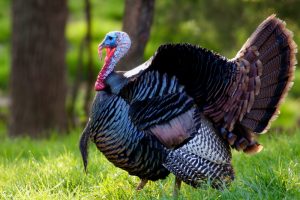
Photo: Kentucky Department Fish and Wildlife
The landscape awakens almost spontaneously from its winter slumber. Winter flocks break up into smaller groups. Innumerable turkey calls and lifelike decoys reappear at sporting goods retailers.
Turkey hunters interpret these occurrences as signs that it will not be long before they are easing into their spots before dawn, filled with anticipation.
In Kentucky, hunters still have ample time to scout and develop a game plan to increase their odds of success in the upcoming spring turkey season. This year, Kentucky’s youth-only season is the weekend of April 7-8. The start of the 23-day general statewide season follows on April 14. It ends May 6.
“Start at the computer then get out in the field to find birds,” said Zak Danks, wild turkey program coordinator with the Kentucky Department of Fish and Wildlife Resources. “Know some different approaches you might take and where you can move based on gobbling you hear once the season starts. Think about some good set-up spots or places to put your decoys, or vantage points to see birds.”
Virtual scouting can save precious time for hunters looking to hunt public land. Topographic maps and satellite views may reveal access points, existing trails, open fields, wooded areas, elevation changes and creeks or fences where approaching gobblers could hang up. Kentucky offers dozens of wildlife management areas and other lands open for public use. As a reminder, turkey calling is not allowed from March 1 until the opening of the youth-only season, and from the close of that season until the opening of the statewide season. Hunters may still use an owl, crow or other calls to locate turkeys while scouting.
It is always a good practice before the season to shoot your shotgun at a paper turkey head target using different brands of turkey loads. By patterning a shotgun ahead of time, the hunter knows the shotgun will shoot where it is aimed and deliver an acceptable number of pellets to the turkey’s vital area (head and neck).
“One thing I’ve learned over the past several years is just how good the hunting can be later in the season,” Danks said. “Last year, in particular, I had hunters contacting me well after the season ended saying they were still hearing turkeys gobble. So don’t get discouraged if you don’t have success early on. There’s still time to find turkeys throughout the season.”
In Kentucky, the spring hunting seasons are timed to give gobblers enough time to breed hens before subjecting the birds to hunting pressure. Kentucky Fish and Wildlife monitors turkey reproduction on a statewide scale through annual summer brood surveys.
Weather during the nesting period in May and June influences reproductive success. Heavy rains in Kentucky and surrounding states during that timeframe last year affected nesting success, which reflected in a statewide average of 1.2 pounds per hen. A figure of 2.0 or higher is optimal. Hunters should expect to encounter fewer of the more easily fooled jakes as a result this season.
Kentucky annually ranks first or second among surrounding states in the number of turkeys taken per square mile.
Hunters took a record number of birds during the 2010 spring season and have averaged more than 31,000 birds over the seven seasons since.
Last spring, hunters reported taking 33,061 birds, which represents a 6 percent increase over the previous year and the third highest total on record. Muhlenberg County led all counties with hunters reporting 681 birds taken there. Looking at it differently, Pendleton County led the state with 1.76 birds harvested per square mile.
The majority of counties are showing a stable to increasing harvest trend over the past decade. Some counties are exhibiting lower harvest totals. In response, Kentucky Fish and Wildlife is expanding efforts to monitor the turkey population and reproduction. Feedback from hunters will play an important role.
A new spring hunting log and post-season survey will soon be available on the department’s website at www.fw.ky.gov. On the homepage, type “Spring Turkey Hunting” into the search box. The log serves to collect information about a hunter’s daily hunting effort, number of turkeys seen, heard and harvested, observations about weather and other species observed. The post-season survey will include questions about spring hunting experiences.
“Our harvest totals tell us that we’re still in a pretty good situation on a statewide level,” Danks said. “We are hearing from people who tell us they’re not seeing as many turkeys as they had in the past. Most of that is from counties that have shown a decrease in harvest. What’s the reason? It’s difficult to determine on a statewide scale when all we’ve had to go on is harvest. We need information on hunter effort on a county level.
“The information gained from these hunter surveys and logs should help us track trends across the state.”
Hunters are allowed a limit of two bearded birds during the spring season, but no more than one bearded bird may be taken in a day.
The 2018 Kentucky Spring Hunting Guide provides information about current regulations, licenses and permits, legal equipment, safety tips and more. Find it online at fw.ky.gov or wherever licenses are sold.
Hunters also will have an opportunity to have their questions about spring turkey season answered during a special “Kentucky Afield” TV call-in show scheduled Saturday, March 24. The live one-hour show will air at 8 p.m. Eastern/7 p.m. Central on Kentucky Educational Television (KET). Joining host Chad Miles for the show will be Danks and pioneering turkey hunter Harold Knight.
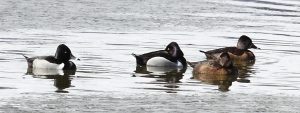
Photo: Kentucky Department Fish And Wildlife
The outlook for the upcoming waterfowl hunting seasons looks as promising as any seasons in recent memory.
“It is shaping up to be a phenomenal year,” said John Brunjes, migratory bird coordinator for the Kentucky Department of Fish and Wildlife Resources. “We are still at all-time highs for duck numbers with as many breeding ducks as we’ve ever had. It’s been that way for a couple of years now.”
Brunjes said biologists conducted duck population counts along the Mississippi River in Illinois last week. They produced four times the normal number of birds counted. “Usually for the second week of November in Illinois, they see about 200,000 birds,” he said. “They counted 800,000 birds along the Mississippi River last week and those birds are heading our way.”
Waterfowl of all stripes are migrating through Kentucky right now. “We are seeing white-fronted geese and even tundra swans in southeast Kentucky,” Brunjes said. “It is very rare. We have a ton of snow geese showing up in weird places this year. The birds are moving well this year.”
The duck, coot, and merganser seasons all open Thanksgiving Day, Nov. 23. The opening segment of the hunting season for ducks, coots and mergansers runs until Nov. 26. These seasons open again Dec. 4, 2017, and close Jan. 28, 2018.
The hunting season for Canada, white-fronted, brant and snow geese also open Thanksgiving Day, but do not close until Feb. 15, 2018.
“We want to remind hunters there is an extended opportunity for geese,” Brunjes said. “The extended season went into effect last year.” Traditionally, goose seasons closed in late January.
A summer devoid of long dry periods set the table for excellent waterfowl habitat this fall. “The moist soil areas and native vegetation look really good,” Brunjes said. “The crops on our wildlife management areas (WMAs) did well. We have the best crops at Ballard WMA that we’ve had in a number of years.”
Finding a place to waterfowl hunt is a challenge for the majority of Kentucky hunters. The first place to check is the public land hunting section of the 2017-2018 Kentucky Hunting Guide for Waterfowl. This section details the hunting options and regulations on public lands, mainly wildlife management areas.
Many, but not all, of the smaller state-owned or managed lakes are open to waterfowl hunting as are reservoirs operated by the U.S. Army Corps of Engineers or the U.S. Forest Service. The bigger waters hold more birds during the coldest stretches of the year, when many farm ponds or smaller lakes freeze over. Call the Kentucky Fish and Wildlife information center at 1-800-858-1549 to inquire if a lake is open to waterfowl hunting.
Those pursuing waterfowl on reservoirs must not hunt near access areas such as boat ramps or areas closed to hunting or public access by signs. Common sense and courtesy dictates waterfowl hunters avoid setting up near private residences or marinas.
Scouting is vitally important to waterfowl hunting success, especially in the first month of the season.
“If you aren’t seeing any birds in the areas you hoped to hunt prior to opening day, you likely won’t see birds on opening weekend either,” Brunjes said. “You have to find the areas birds are using and set up accordingly.”
Waste corn in cut silage fields provides excellent food for ducks and geese. Goose hunters may find agreeable farmers who consider geese a nuisance. Goose hunting in harvested cornfields provides excellent sport and peaks with the coldest weather.
Those farmers may also grant permission to hunt their ponds. From the air, farm ponds dot the Kentucky landscape as craters do the Moon. They can provide the hottest hunting, but not all farm ponds attract birds. Scouting is vital for successful farm pond hunting.
Waterfowl hunters must have a valid Kentucky hunting license, a Kentucky migratory game bird – waterfowl permit along with a Federal Duck Stamp. Federal Duck Stamps are available at post offices across Kentucky.
Waterfowl hunters must have their Harvest Information Program (H.I.P.) confirmation number recorded on either their Kentucky hunting license or on their Kentucky migratory game bird – waterfowl permit. To get your H.I.P. number, visit the Kentucky Fish and Wildlife website at www.fw.ky.gov and click on the “My Profile” tab. Answer a few questions about last season’s harvest of migratory birds to receive your confirmation number. The process takes less than 5 minutes.
“Folks in the neighboring states to our north such as Illinois, where waterfowl seasons are already open, are having great hunting so far,” Brunjes said. “It is early and a lot remains to be seen, but everything is setting up for a great season.”
 Weather
Weather Traffic
Traffic @LouisvilleDispatch
@LouisvilleDispatch @LouisvilleDisp
@LouisvilleDisp Subscribe
Subscribe